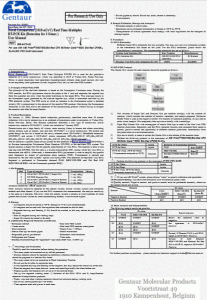Wuhan, China and a new coronavirus (CoV) has been identified as a possible pathogen causing this outbreak.
Please be advised that we have successfully developed Novel Coronavirus (2019-nCoV) Real Time RT-PCR Kit(Cat. #: RR-0478-02) to detect this new coronavirus.
1250 Euro from Gentaur
Some countries have stepped up preventive measures including airport temperature screening for travelers arriving from Wuhan in the wake of this outbreak.
nCorV NatTrol nucleic acid control can be used as positive control for this qPCR test.
Coronavirus (2019-nCoV)

For use with
- ABI Prism®7500/7900;
- Bio-Rad CFX 96;
- Rotor Gene™6000;
- Bio-Rad CFX96
- SLAN;MICPOCDx 48 Instrument
1. Intended Use
Novel Coronavirus (2019-nCoV) Real Time Multiplex RT-PCR Kit is used for the qualitative detection of a novel coronavirus, which was identified in 2019 at Wuhan City, Hubei Province, China, in upper respiratory tract specimens (nasopharyngeal extracts, deep cough sputum, etc.) and lower respiratory tractspecimens(alveoli irrigationfluid,etc.) by realtime PCR systems.
2. Principle of Real-TimePCR
The Gentaur principle of the real-time detection is based on the fluorogenic 5’nuclease assay. During the PCR reaction, the DNA polymerase cleaves the probe at the 5’ end and separates the reporter dye from the quencher dye only when the probe hybridizes to the target DNA. This cleavage results in the fluorescent signal generated by the cleaved reporter dye, which is monitored real-time by the PCR detection system. The PCR cycle at which an increase in the fluorescence signal is detected initially (Ct) is proportional to the amount of the specific PCR product. Monitoring the fluorescence intensities in real time allows the detection of the accumulating product without having to re-open the reaction tube after the amplification.
3. Product Description
On January 11, 2020, Chinese health authorities preliminarily identified more than 40 human infections with a novel coronavirus in an outbreak of pneumonia under investigation in Wuhan City, Hubei Province, China. The Chinese authorities identified a new type of coronavirus (novel corona-virus,named as 2019-nCoV), which was isolated on7 January 2020. Corona-viruses are a large family of viruses, some causing illness in human and others circulating among animals such as camels, cats and bats. 2019-nCoV is a novel coronavirus. The primer and probe design for this kit is based on the newly released strain (2019-nCoV) (GeneBank accession: MN908947) and covers 6 2019-nCoV strains sequences (EPI_ISL_402119, EPI_ISL_402120, EPI_ISL_402121,EPI_ISL_402122,EPI_ISL_402123, EPI_ISL_402124included). The kit contains a specific ready-to-use system for the detection of Novel Coronavirus (2019-nCoV) by Reverse transcription Polymerase Chain Reaction (RT-PCR) in the real-time PCR system. The master contains a Super Mix forthe specific amplification of virus RNA. The reaction is done in one step real time RT-PCR. The first step is a reverse transcription (RT), during which the virus RNA is transcribed into cDNA. Afterwards, a thermostable DNA polymerase is used to amplify the specific gene fragments by means of polymerase chain reaction (PCR). Fluorescence is emitted and measured by the real time systems´ optical unit during PCR. The detection of amplified virus DNA fragment is performed in fluorimeter channel FAM, HEX/VIC/JOE and Cal Red 610/ ROX/TEXASRED with the fluorescent quencher BHQ1. NatTrol can be used as control.
4. Kit Contents
Ref. Typeofreagent Presentation 25rxns 1 2 3 4 NovelCoV(2019-nCoV)SuperMix RT-PCREnzymeMix NovelCoV(2019-nCoV)NegtiveControl NovelCoV(2019-nCoV)PositiveControl 1vial, 480l 1vial, 28l 1vial, 400μl 1vial, 30μl Analysissensitivity:1×103 copies/ml; Note: Analysis sensitivity depends on the sample volume, elution volume, nucleic acid extraction method and other factors. If you use the RNA extraction kits recommended, the analysis sensitivity is the same as it declares. However, when the sample volume is dozens or even hundreds of times greater than elution volume by some concentrating method, it can be much higher.
5. Storage
•Allreagents shouldbestoredat-20°C.Storageat+4°Cisnotrecommended. •Allreagents canbeuseduntiltheexpirationdateindicatedonthekitlabel. • Repeated thawing and freezing (> 3x) should be avoided, as this may reduce the sensitivity of theassay. •Coolallreagentsduringtheworkingsteps. •SuperMixshouldbestoredinthedark.
6. Additionally Required Materials and Devices
•Biological cabinet •Vortexmixer •Cryo-container •Sterilefiltertipsformicro pipets •Disposable gloves,powderless •RefrigeratorandFreezer •RealtimePCRsystem •RealtimePCRreactiontubes/plates •Pipets(0.5μl–1000μl) •Sterilemicrotubes •Biohazardwastecontainer •Tuberacks •Desktopmicrocentrifuge for“eppendorf”typetubes(RCFmax.16,000xg)
7. Warnings and Precaution
Carefullyreadthisinstructionbeforestartingtheprocedure. •Thisassayneedstobecarriedoutbyskilledpersonnel. •Clinicalsamplesshouldberegarded aspotentiallyinfectious materialsand shouldbepreparedinalaminarflowhood. •ThisassayneedstoberunaccordingtoGoodLaboratoryPractice. •Donotusethekitafteritsexpirationdate. •Avoidrepeatedthawingandfreezing ofthereagents,thismayreducethesensitivityofthetest. •Oncethereagentshavebeenthawed,vortexandcentrifugebrieflythetubesbeforeuse. •PreparequicklytheReactionmixoniceorinthecoolingblock. • Set up two separate working areas: 1) Isolation of the RNA/ DNA and 2) Amplification/ detectionofamplificationproducts. •Pipets,vialsandotherworkingmaterialsshouldnotcirculateamongworkingunits. •Usealways sterilepipettetipswithfilters. •Wearseparate coatsandglovesineacharea.

